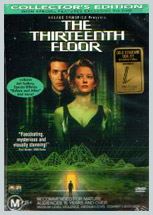|
Review added January 13, 2005.
The
Thirteenth Floor
:: DVD Review |
|
.
. |
|
|
|
| |
 |
|
|
Studio:
Columbia TriStar |
 |
>> Review
Equipment |
|
Video:
2.35:1 (Enhanced for 16:9) |
 |
Length:
96
Minutes |
|
Audio:
Dolby Digital 5.1 (384kbps) En |
 |
Subtitles: En/Du/Gr/Hu/Sv/No/Fi/Dan/Pol |
|
Video Format:
PAL |
 |
 Hi/Heb/Tur/Ice/Cz Hi/Heb/Tur/Ice/Cz |
|
Layer Change:
NA |
|
Disc Format:
DVD-5 |
|
Average Bit-Rate (A+V):
X.XXMbps |
 |
Disc Capacity Utilised:
X.XXGB |
| |
 |
Region Coding:
4 |
| |
|
|
|
|
|
|
.
. |
|
:: The Film
:: |
|
>> Skip to
Audio/Video Details
Released hard on the heels of The
Matrix, comparisons between The Thirteenth Floor and the
former (not to mention Dark City and eXistenZ) were
inevitable but not entirely fair. The Thirteenth Floor and
The Matrix are really quite different from one another, one
being a science fiction/action film and the other a murder
mystery with a small science fiction element; both merely
rely on a similar conceptual foundation: artificial
realities.
Few would disagree that The Matrix
is a better film than The Thirteenth Floor, which is
burdened with an overly complicated plot and a conclusion
that can be seen coming from a mile away (at night, by a
blind person), but The Thirteenth Floor deserves to be
considered on its own merits. Hannon Fuller (Armin
Mueller-Stahl) is a visionary virtual reality researcher
who, to test a new virtual reality system, artificially
recreates the world of 1930s Los Angeles.
|
 |
As a consequence of his experimentation, Fuller stumbles
upon an amazing secret about his machine, but is murdered
before he is able to pass it on. Suspicion immediately falls
on his business partner, Douglas Hall (Craig Bierko), who is
unable to account for his whereabouts at the time of the
murder and stands to acquire sole control of the company.
Immediately following Fuller's death a mysterious young
woman (Gretchen Mol) comes forward claiming to be Jane
Fuller, Hannon Fuller's daughter. Ms. Fuller claims to have
been sent for by her father, who planned to dissolve the
company. Hall, a close friend and confidant of Fuller's, is
completely unaware of these alleged plans or even that
Fuller had a daughter.
His suspicions aroused, Hall begins
investigating Fuller's death and 'daughter', which
eventually leads him back to Fuller's artificial world. As
Hall uncovers more about Fuller's death and the mysterious
woman, he slowly comes to realise the secret that Fuller
took with him to the grave, a secret that will forever alter
Hall's world and concept of reality.
The Thirteenth Floor's basic premise is
quite intriguing, but the film's execution is somewhat
disappointing and certainly doesn't live up to the concept's
potential. Quite apart from the unnecessarily convoluted
plot, the film's main failing is the cast. Mol and Bierko
are strangely lethargic, and the only performance of note
comes from the underrated Vincent D'Onofrio. The film's
production, on the other hand, is dazzling with some
spectacular recreations of 1930s Los Angeles. There's no
doubt this could have been a better film (changing the
clearly tacked-on ending would have helped no end) but the
end result is still thought-provoking and entertaining.
|
|
| ::
Video
:: |
.
. |

|
This 2.35:1 anamorphically-enhanced transfer comes to us
from Columbia TriStar, so expectations were naturally
high, and while this is certainly a good transfer I was
slightly disappointed with the end result. The film print
used was in relatively poor condition for such a new film
and film artefacts were often present, with noticeable
problems at 17:05 (large vertical line), 53:30 (large
watermark), and 131:12 and 126:66 (large black dots).
Small nicks and hairs are also visible throughout the film
and grain is occasionally very obvious, with several
scenes looking unusually bad, as at 37:20, 55:15 and
111:19. The image is also very soft on more than a few
occasions, as at 100:12.
On the plus side, colours and skin tones are
excellent: very stable and richly saturated throughout the
film (if somewhat subdued in Fuller's 1930s artificial
world, intentionally so I might add). The image is usually
sharp and clear, and several brightly-lit sequences look
very good indeed. There is little noticeable edge
enhancement, no obvious compression artefacts and very
little aliasing. Blacks are excellent, but shadow detail
is almost non-existent. The transfer is good overall, but
the terms 'soft' and 'grainy' certainly spring to mind,
costing it a few points.
|
 |
|
.
. |
| :: Audio
:: |
.
. |
|

|
This Dolby Digital 5.1 soundtrack is quite nice, with a fairly
expansive front soundstage containing many nicely executed
directional cues. There are very few audio pans across the
front channels, but those present are smooth and well
integrated. The surround channels are used effectively if
sporadically, containing surprisingly few discrete directional
effects, with a helicopter flyby through the right surround
channel at 19:09 and rain in the left surround channel at
109:33 the only discrete effects of note. The surround
channels are used primarily for ambient effects and music,
nicely enveloping the listener in sound when used.
The LFE channel is used infrequently
but is most dramatic when active, reinforcing gunshots, the
film's score and music, and any scene involving the 'machine'.
Overall bass reproduction is very good from both the LFE and
front channels, although LFE activity sometimes seemed a
little excessive. Dialogue is well recorded, with the
exception of several instances of distinctly 'boxy' sounding
dialogue and slight sibilance. ADR dialogue isn't always
synchronised particularly well, as at 51:39 but is
acoustically accurate at all times.
|
 |
|
.
. |
|
|